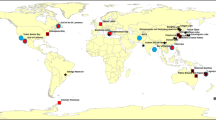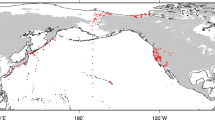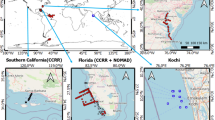Abstract
The inherent optical parameters play a very important role in determining the concentration of seawater components. One such inherent parameter, the absorption coefficient (a), is greatly significant when calculating each component’s content in water and simulating the water’s biological, physical and chemical properties. Quasi-analytical algorithm (QAA) is one of current inherent optical parameters inversion algorithms. In this study, we compared three versions of QAA, including QAA_V4, QAA_V5 and more recently QAA_V6, using IOCCG data set. The results showed that QAA_V4 model performs best for the inversion of the absorption coefficient at 443 nm, with MRE, RMSE and R2 values of 11.82%, 0.1995 and 0.9099, respectively, while QAA_V6 has the highest accuracy when inverting a at 555 nm and 670 nm wavelengths. Next, we tested the three models using MODIS product data, including data from case I and case II waters. The data is extracted from image, after position matching, then was imported into the three QAA models to calculate their RMSE, MRE and R2 values. The QAA model showed a high accuracy and robust applicability for absorption coefficient inversion at shorter wavelengths, such as 443 nm. Future research should include verification with more complicated water bodies, solidifying the foundation for implementing QAA into ocean color remote sensing research.










Similar content being viewed by others
References
Aurin DA, Dierssen HM (2012) Advantages and limitations of ocean color remote sensing in CDOM-dominated, mineral-rich coastal and estuarine waters. Remote Sens Environ 125:181–197
Cao Z, Ma R, Duan H, Xue K (2019) Effects of broad bandwidth on the remote sensing of inland waters: implications for high spatial resolution satellite data applications. ISPRS J Photogramm Remote Sens 153:110–122
Chen S, Zhang T (2015) Evaluation of a QAA-based algorithm using MODIS land bands data for retrieval of IOPs in the eastern China seas. Opt Express 23(11):13953–13971
Dong Q, Shang S, Lee Z (2013) An algorithm to retrieve absorption coefficient of chromophoric dissolved organic matter from ocean color. Remote Sens Environ 128:259–267
Gordon HR, Morel AY (2012) Remote assessment of ocean color for interpretation of satellite visible imagery: a review, vol 4. Springer Science & Business Media
Gordon HR, Brown OB, Evans RH, Brown JW, Smith RC, Baker KS, Clark DK (1988) A semianalytic radiance model of ocean color. J Geophys Res: Atmospheres 93(D9):10909–10924
Imai N (2016) Parametrization and calibration of a quasi-analytical algorithm for tropical eutrophic waters. ISPRS J Photogramm Remote Sens 121(Nov):28–47
Joshi ID, D'Sa EJ (2018) An estuarine-tuned quasi-analytical algorithm (QAA-V): assessment and application to satellite estimates of SPM in Galveston Bay following hurricane Harvey. Biogeosciences 15(13):4065–4086
Le CF, Li YM, Zha Y, Sun D, Yin B (2009) Validation of a quasi-analytical algorithm for highly turbid eutrophic water of Meiliang Bay in Taihu Lake, China. IEEE Trans Geosci Remote Sens 47(8):2492–2500
Lee Z (2006) Remote sensing of inherent optical properties: fundamentals, tests of algorithms, and applications
Lee Z, Carder KL (2004) Absorption spectrum of phytoplankton pigments derived from hyperspectral remote-sensing reflectance. Remote Sens Environ 89(3):361–368
Lee ZP, Zhang MR, Carder KL, Hall LO (1998) A neural network approach to deriving optical properties and depths of shallow waters
Lee Z, Carder KL, Mobley CD, Steward RG, Patch JS (1999) Hyperspectral remote sensing for shallow waters: 2. Deriving bottom depths and water properties by optimization. Appl Opt 38(18):3831–3843
Lee Z, Carder KL, Arnone RA (2002) Deriving inherent optical properties from water color: a multiband quasi-analytical algorithm for optically deep waters. Appl Opt 41(27):5755–5772
Lee ZP, Darecki M, Carder KL, Davis CO, Stramski D, Rhea WJ (2005) Diffuse attenuation coefficient of downwelling irradiance: an evaluation of remote sensing methods. J Geophys Res: Oceans 110 (C2)
Lee ZP, Weidemann A, Kindle J, Arnone R, Carder KL, Davis C (2007) Euphotic zone depth: its derivation and implication to ocean-color remote sensing. J Geophys Res Oceans 112 (C3)
Lee ZP, Weidemann A, Kindle J, Arnone R, Carder KL, Davis C (2007) Euphotic zone depth: its derivation and implication to ocean-color remote sensing. J Geophys Res Oceans 112 (C3)
Lee Z, Lubac B, Werdell J, Arnone R (2009) An update of the quasi-analytical algorithm (QAA_v5). International Ocean Color Group Software Report:1–9.
Lee Z, Arnone R, Hu C, Werdell PJ, Lubac B (2010) Uncertainties of optical parameters and their propagations in an analytical ocean color inversion algorithm. Appl Opt 49(3):369–381
Lee ZP, Du K, Voss KJ, Zibordi G, Lubac B, Arnone R, Weidemann A (2011) An inherent-optical-property-centered approach to correct the angular effects in water-leaving radiance. Appl Opt 50(19):3155–3167
Lee Z, Hu C, Shang S, Du K, Lewis M, Arnone R, Brewin R (2013) Penetration of n +UV-visible solar radiation in the global oceans: insights from ocean color remote sensing. J Geophys Res: Oceans 118(9):4241–4255
Lee Z, Lubac B, Werdell J (2014) Update of the quasi-analytical algorithm (QAA_v6)[R/OL]. Interna-Tional Ocean color group software report [2013-04-03] http://wwwioccg, org/groups/software-OCA/OAA _ 5
Lee Z, Wei J, Voss K, Lewis M, Bricaud A, Huot Y (2015) Hyperspectral absorption coefficient of “pure” seawater in the range of 350–550 nm inverted from remote sensing reflectance. Appl Opt 54(3):546–558
Liu X, Devred E, Johnson C (2018) Remote sensing of phytoplankton size class in Northwest Atlantic from 1998 to 2016: bio-optical algorithms comparison and application. Remote Sens 10(7):1028
Mishra DR (2014) Bio-optical inversion in highly turbid and cyanobacteria-dominated waters. IEEE Trans Geosci Remote Sens 52:375–388
Mishra S, Mishra DR (2013) Quantifying cyanobacterial phycocyanin concentration in turbid productive waters: a quasi-analytical approach. Remote Sens Environ 133(complete):141–151
Morel A (1974) Optical properties of pure water and pure sea water. Optical Aspects Oceanography 1(1):1–24
Morel A, Prieur L (1977) Analysis of variations in ocean color 1. Limnol Oceanogr 22(4):709–722
Shi L, Mao Z, Wang Z, Zhang Y, Hao Z, Zhu Q, Wang D, Gong F, Huang H (2018) Validation of a green-red quasi-analytical algorithm for inherent optical properties in East China Sea. In: Remote Sensing of the Ocean, Sea Ice, Coastal Waters, and Large Water Regions 2018. International Society for Optics and Photonics, p 1078414
Sun DY, Li YM, Wang Q, Lu H, Le CF, Huang CC, Gong SQ (2011) A neural-network model to retrieve CDOM absorption from in situ measured hyperspectral data in an optically complex Lake: Lake Taihu case study. Int J Remote Sens 32(14):4005–4022
Wang Y, Shen F, Sokoletsky L, Sun X (2017) Validation and calibration of QAA algorithm for CDOM absorption retrieval in the Changjiang (Yangtze) estuarine and coastal waters. Remote Sens 9(11):1192
Willmott CJ, Matsuura K (2005) Advantages of the mean absolute error (MAE) over the root mean square error (RMSE) in assessing average model performance. Clim Res 30(1):79–82
Yang W, Matsushita B, Chen J, Yoshimura K, Fukushima T (2012) Retrieval of inherent optical properties for turbid inland waters from remote-sensing reflectance. IEEE Trans Geosci Remote Sens 51(6):3761–3773
Yang W, Matsushita B, Chen J, Yoshimura K, Fukushima T (2013) Application of a semianalytical algorithm to remotely estimate diffuse attenuation coefficient in turbid inland waters. IEEE Geosci Remote Sens Lett 11(6):1046–1050
Zeng C, Zeng T, Fischer A, Xu H (2017) Fluorescence-based approach to estimate the chlorophyll-a concentration of a phytoplankton bloom in ardley cove (Antarctica). Remote Sens 9(3):210
Zheng G, Stramski D, Reynolds RA (2014) Evaluation of the quasi-analytical algorithm for estimating the inherent optical properties of seawater from ocean color: comparison of Arctic and lower-latitude waters. Remote Sens Environ 155:194–209
Acknowledgments
This paper is financially supported by National Key R&D Program of China (2018YFC1407400) and the National Natural Science Foundation of China (No.52078324), Major Research on Philosophy and Social Sciences of the Ministry of Education of China (No.19JZD056 and No.2018JZD059) for their funding of this research. And the authors would like to sincerely thank the editor and the anonymous reviewers.
Author information
Authors and Affiliations
Corresponding authors
Additional information
Publisher’s note
Springer Nature remains neutral with regard to jurisdictional claims in published maps and institutional affiliations.
Appendix
Appendix
Rights and permissions
About this article
Cite this article
Zhan, J., Zhang, D., Tan, L. et al. Performance analysis of inverting optical properties based on quasi-analytical algorithms. Multimed Tools Appl 81, 4693–4709 (2022). https://doi.org/10.1007/s11042-021-10748-9
Received:
Revised:
Accepted:
Published:
Issue Date:
DOI: https://doi.org/10.1007/s11042-021-10748-9




